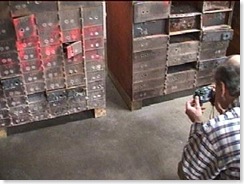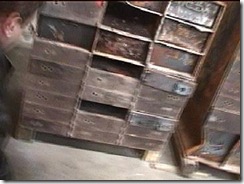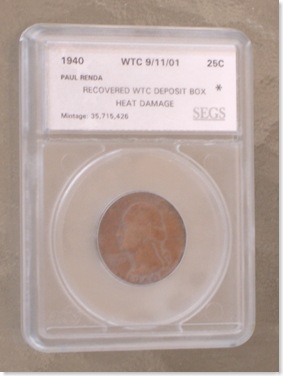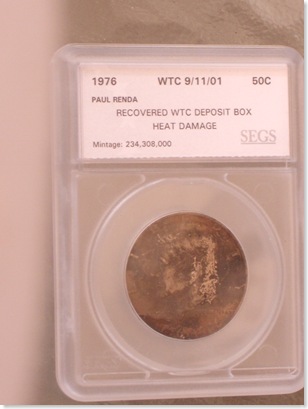A Treasure in Silver and Gold 2
- May 17th, 2008
- Posted in Research Comex Vault
A Treasure in Silver and Gold
RICH GARLOCK: The vault was huge — two levels, 3,000 square feet each. When they opened the door, I realized why it was so big: there was a lot of gold and silver. The silver bars were like large loaves of bread, only they weighed about 70 pounds. The gold was smaller, but also very heavy, about 28 pounds each. It was around Halloween and I joked that I was going to come dressed as a Brinks guard. The team did a test run with the Brinks truck to make sure that it had the clearance, driving it up and then back out. The next morning the New York Post reported the vault had been emptied. In fact, it took a week to remove. The police said, "Hey, we couldn't have better publicity."
http://www.pbs.org/americarebuilds/engineering/engineering_property_02.html
Times Article Nov. 1 2001
- May 16th, 2008
- Posted in Research Comex Vault
November 01, 2001
Crushed towers give up cache of gold ingots
From Nicholas Wapshott in New York
RECOVERY workers at Ground Zero have discovered hundreds of gold ingots, part of a billion dollar cache which was lost when the twin towers fell.
Workers clearing rubble in a service tunnel underneath one of the collapsed World Trade Centre buildings found themselves surrounded by more than 100 armed FBI and secret service personnel, who had been tipped off by the owners where the gold was buried.
The collapsed buildings contained a number of vaults and strongrooms, but the police were not saying who owned the gold.
The Comex metals trading division of the New York Mercantile Exchange kept 3,800 gold bars — weighing 12 tonnes and worth more than $100 million (£70 million) — in vaults in the building’s basement. Comex also held almost 800,000 ounces of gold there on behalf of others with a value of about $220 million. It also held more than 102 million ounces of silver, worth $430 million.
The Bank of Nova Scotia, which kept gold in the Comex vault, reported $200 million of gold lost in the wreckage. Comex also held precious metals for Chase Manhattan Bank, the Bank of New York and Hong Kong and Shanghai Banking.
The vaults higher up the towers became burial chambers on September 11 as some workers tried in vain to protect themselves from the fire and smoke by taking refuge inside them.
The gold, which was discovered on Tuesday, was being transported through the basement of the building on the morning of September 11. Recovery workers reached a service tunnel and discovered a ten-wheel lorry and a number of cars which had been crushed by falling steel.
A temporary ramp was built to gain access to the tunnel and a small bulldozer was used to break through a wall. Then a team of police and firefighters arrived to put the gold into an armoured bullion lorry. Other workers were told to make themselves scarce. “If I tried to go down there they would have shot me,” one said.
Eight years ago, when the World Trade Centre was bombed by terrorists, more than $1 billion in gold was being kept in the basement vaults, the property of the Kuwaiti Government. The vaults withstood the blast.
At first police believed the terrorist attack was an attempted gold robbery. Since then the amount of gold kept under the World Trade Centre has been a carefully guarded secret.
http://911research.wtc7.net/cache/wtc/evidence/timesonline_gold.html
Article Clips Of WTC Vault
- May 15th, 2008
- Posted in Research Comex Vault
Gold Heist Story Heist
The basement of 4 World Trade Center housed vaults used to store gold and silver bullion. Published articles about precious metals recovered from the World Trade Center ruins in the aftermath of the attack mention less than $300 million worth of gold. All such reports appear to refer to a removal operation conducted in late October of 2001. On Nov. 1, Mayor Rudolph Giuliani announced that "more than $230 million" worth of gold and silver bars that had been stored in a bomb-proof vault had been recovered. A New York Times article contained: 2
Two Brinks trucks were at ground zero on Wednesday to start hauling away the $200 million in gold and silver that the Bank of Nova Scotia had stored in a vault under the trade center ... A team of 30 firefighters and police officers are helping to move the metals, a task that can be measured practically down to the flake but that has been rounded off at 379,036 ounces of gold and 29,942,619 ounces of silver ..
Another article gave a figure of $650 million to the value of gold in the 4 WTC vault.
An article in the TimesOnline gives the following rundown of precious metals that were being stored in WTC vaults belonging to Comex.
- Comex metals trading - 3,800 gold bars weighing 12 tonnes and worth more than $100 million
- Comex clients - 800,000 ounces of gold with a value of about $220 million
- Comex clients - 102 million ounces of silver, worth $430 million
- Bank of Nova Scotia - $200 million of gold
The TimesOnline article is not clear as to whether the $200 million in gold reported by the Bank of Nova Scotia was part of the $220 million in gold held by Comex for clients. If so, the total is $750 million; otherwise $950 million.
There appear to be no reports of precious metals discovered between November of 2001 and the completion of excavation several months later. It would seem that at least the better part of a billion dollars worth of precious metals went missing. It is not plausible that whatever destroyed the towers vaporized gold and silver, which are heavy malleable metals that are extremely unlikely to participate in chemical reactions with other materials.
The authors of the book 9/11 Revealed were apparently so impressed with the story that they paid 9-11 Research the ultimate compliment -- they plagiarized the story. The following passage from the 9-11 Research critique of the book explains how the report was lifted by 9/11 Revealed without credit:
One of the more egregious examples of the book's appropriation without credit of 911Research's reporting is its paragraph covering the discrepancy between the value of precious metals reportedly stored under the World Trade Center and the value reported recovered after the attack.
9/11 Revealed copies this image, along with the gist of 911Research's original reporting, without crediting 911Research.
Some $230 million worth of gold was discovered in a lorry in a tunnel under the Center in November 2001. 21 We have seen no reports of other caches being found. However, Comex was reported to have at least $950 million worth of gold stored in its vault under the Center, and the fate of that haul remains unknown. 22
[page 107]
21 "Below Ground Zero, Silver and Gold", New York Times, 1 November 2001
22 National Real Estate Investor, 19 November 2001
[page 240]
Compare this excerpt to the [ archived excerpt], which has existed in its current form on 911Research since late 2003. The two references cited by 9/11 Revealed for this story are References 1 and 4 from our page. The $950 million figure comes from 911Research, not from reference 22.
Unknown to most people at the time, $650 million in gold and silver was being kept in a special vault four floors beneath Four World Trade Center. The gold and silver were recently recovered.
More at this link.
http://911research.wtc7.net/wtc/evidence/gold.html
Pictures From Ground Zero Vault
- April 25th, 2008
- Posted in Paul Renda WTC Coins, Research Comex Vault
These pictures where provided by Paul Renda, his coins where in the vault under the world trade center around 250 coins where in his box when he open it up. This is his word about the coins from his Chase Manhattan Bank deposit box "They were in the main zone of destruction and were subjected to 1500 degrees for 7 -10 days. My coins went from MS65+ to VF in the time it took to dig them out . ( when bad things happen to good coins). Paul Renda stated that his coins where at the chase Manhattan bank next to the world trade center and in the main debris of the world trade center. Look for the Paul Renda coin story here in a few days.
A Numismatic Catastrophe
- April 4th, 2008
- Posted in Paul Renda WTC Coins, Research Comex Vault
By Ron Guth
Published in Rare Coin Market Report November 2007 www.pcgs.com
This is a true story from 9/11-- one with a numismatic angle. What you are about to read pales in comparison to the loss of human life on that fateful day, but this is a story that needs to be told.
Imagine this nightmare scenario: your bank, where your coins are stored in a safe deposit box, calls to tell you that the bank building collapsed and all that's left is a pile of burning rubble. Plus, it will be month before you can recover anything from your box, assuming the box can be found. That's exactly what happened to collector Paul Renda. You see, Paul's coins were inside a box...inside a vault... inside a New York branch of JP Morgan Chase...inside a skyscraper....which was one of the twin towers known as the World Trade Center On September 11, 2001, terrorists flew planes into each of the towers, causing them to burn and collapse, taking with them nearly 3000 lives and destroying billion of dollars worth of property-- including Paul's coins.
Rescue operations began immediately but were hampered by smoldering fires, poor aor quality and fears of additional collapses due to the unstable structure of the immense pile of rubble. When it became apparent that there were no more survivors, the effort became a recovery and cleanup operation. Demolition crew picked apart the twisted steel and crushed concrete, searching for human remains, recovering lost property and moving away big and small pieces of the towers that once dominated the Manhattan skyline.
Deep beneath the rubble and remains lay a vast assortment of treasures ranging from $230 million in precious metals to entire bank vaults and safe deposit boxes like the one rented by Paul Renda. Eventually, these treasures were recovered and restored to their rightful owners, when such identification was possible. Moths after the collapse, Paul Renda was summoned to a special location to reclaim his treasure. According to the final appraisal report, "The Renda collection of coins is comprised primarily of coins pulled from circulation and a small group of choice un-circulated silver dollars." The inventory list included a variety of coins including Lincoln cents, Shield Nickels, Walking Liberty half dollars, nine silver dollars (six of which were Morgan dollars), and others. In all Paul's box contained 243 coins. Everyone, especially Paul, was anxious to see if his coins had survived and, if they had, what kind of condition they were in. Mr Renda provided PCGS with a videotape of the day he went to recover the contents of his safe deposit box. Watching the video is powerful, as one sees a scene that must have been repeated hundreds, if not thousands of times, by other people claiming the contents of their boxes. The video begins with Paul entering a storage room in which stacks of safe deposit boxes have been placed around the perimeter. The boxes look terrible; they appear burnt, crushed, and many of the doors have already been drilled out or popped open. The fronts have been spray-painted in graffiti-like fashion as a mean of identifying the bank or location in which they were found. Paul is seen scanning each of the stacks, searching for his box (#Z-433), which he finally finds at the lower left corner of one of the burnt-out stacks. The door to Paul's box appears to be in remarkably good shape, better than many of the others, and he attempts to insert his key, to no avail. A technician uses a hammer to punch out the locks and pry open the door. The technician pulls Paul's box out of its drawer and carries it to a makeshift cubicle where the box and its contents can be examined. Paul is given a pair of latex gloves to protect his hands from the soot. The box is charred on the outside but appears to be in good shape, so Paul is hopeful that the contents might have survived. Paul gently opens the lid and peers inside. Paul's hope turns to dismay as the box reveals nothing but the blackened remains of album pages, documents and coins. The temperatures required to melt coins inside a steel box must have been immense. The paper pages of the albums remained intact and appeared to have been turned into charcoal more so than having being burnt. Paul can be seen lifting blackened,individual coins out of the box and laying them onto a sheet of black plastic. As he lift out the individual album pages, coins can be seen dropping from the holes. The pages themselves are very fragile and prone to crumbling. Soon Paul has before him a pitiful pile of burnt album pages and blackened coins. The back of Paul's box contains important documents. Surprisingly most of the documents remain relatively intact as single fragile pages. Paul is able to separate them and, if they don't crumble apart, he can actually read some of them.
Three of Paul's coins are illustrated with this video. Each coin shows severe discoloration and blistering of the surfaces. The melting point of silver is 1,763 degrees Fahrenheit, giving some idea of the inferno these coins endured.
The contents of Paul's box were a disaster. The heat, fire, and corrosive action of the World Trade Center's destruction reduced the value of Paul's collection to that of the bullion value of the silver coins. Likewise, his documents were effectively unsalvageable.
It may come as a surprise to most people, but banks usually have no liability of any kind for the contents of the safe deposit boxes in their care. However, because of the extraordinary circumstances of September 11, JP Morgan Chase offered to compensate Paul for his loss. They hired an outside appraiser to examine the contents of the box and to determine a replacement value for the coins. Surprisingly, the final settlement amount offered by JP Morgan Chase was higher than the hypothetical loss developed by the appraiser. However, Paul decided not to accept the settlement, opting instead to retain all 243 of his coins as memories of this historic event. He plans to donate some of the coins to museums but the bulk of the coins will remain with his family.
Paul Renda's association with the World Trade Center goes beyond this story. Paul was working in the offices of Dean Witter Discover in Two World Trade Center when it was bombed in 1993. He experienced the terror of huddling in a room filling with smoke, not knowing whether to stay put or attempt to make it down to the street. He chose the latter. Paul's cousin Thomas "Tommy" Farino died on 9/11 while responding to the attack. Tommy was a New York Fire Department Captain ( the youngest named Captain of Engine Co. 26) and was promoted posthumously to Battalion Chief.





